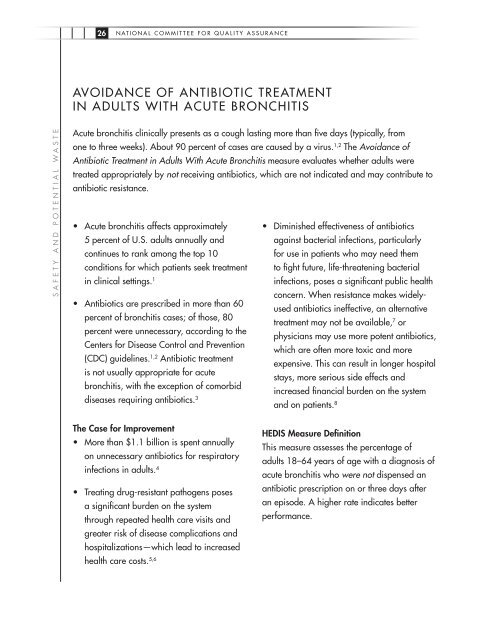Continuous Improvement and the Expansion of Quality ... - NCQA
Continuous Improvement and the Expansion of Quality ... - NCQA
Continuous Improvement and the Expansion of Quality ... - NCQA
Create successful ePaper yourself
Turn your PDF publications into a flip-book with our unique Google optimized e-Paper software.
S A f E T y A N D P o T E N T I A l W A S T E<br />
26<br />
N AT I o N A l C o M M I T T E E f o R Q U A l I T y A S S U R A N C E<br />
AVoIDANCE <strong>of</strong> ANTIbIoTIC TREATMENT<br />
IN ADUlTS WITH ACUTE bRoNCHITIS<br />
Acute bronchitis clinically presents as a cough lasting more than five days (typically, from<br />
one to three weeks). About 90 percent <strong>of</strong> cases are caused by a virus. 1,2 The Avoidance <strong>of</strong><br />
Antibiotic Treatment in Adults With Acute Bronchitis measure evaluates whe<strong>the</strong>r adults were<br />
treated appropriately by not receiving antibiotics, which are not indicated <strong>and</strong> may contribute to<br />
antibiotic resistance.<br />
• Acute bronchitis affects approximately<br />
5 percent <strong>of</strong> U.S. adults annually <strong>and</strong><br />
continues to rank among <strong>the</strong> top 10<br />
conditions for which patients seek treatment<br />
in clinical settings. 1<br />
• Antibiotics are prescribed in more than 60<br />
percent <strong>of</strong> bronchitis cases; <strong>of</strong> those, 80<br />
percent were unnecessary, according to <strong>the</strong><br />
Centers for Disease Control <strong>and</strong> Prevention<br />
(CDC) guidelines. 1,2 Antibiotic treatment<br />
is not usually appropriate for acute<br />
bronchitis, with <strong>the</strong> exception <strong>of</strong> comorbid<br />
diseases requiring antibiotics. 3<br />
<strong>the</strong> Case for <strong>Improvement</strong><br />
• More than $1.1 billion is spent annually<br />
on unnecessary antibiotics for respiratory<br />
infections in adults. 4<br />
• Treating drug-resistant pathogens poses<br />
a significant burden on <strong>the</strong> system<br />
through repeated health care visits <strong>and</strong><br />
greater risk <strong>of</strong> disease complications <strong>and</strong><br />
hospitalizations—which lead to increased<br />
health care costs. 5,6<br />
• Diminished effectiveness <strong>of</strong> antibiotics<br />
against bacterial infections, particularly<br />
for use in patients who may need <strong>the</strong>m<br />
to fight future, life-threatening bacterial<br />
infections, poses a significant public health<br />
concern. When resistance makes widelyused<br />
antibiotics ineffective, an alternative<br />
treatment may not be available, 7 or<br />
physicians may use more potent antibiotics,<br />
which are <strong>of</strong>ten more toxic <strong>and</strong> more<br />
expensive. This can result in longer hospital<br />
stays, more serious side effects <strong>and</strong><br />
increased financial burden on <strong>the</strong> system<br />
<strong>and</strong> on patients. 8<br />
HEdIs Measure definition<br />
This measure assesses <strong>the</strong> percentage <strong>of</strong><br />
adults 18–64 years <strong>of</strong> age with a diagnosis <strong>of</strong><br />
acute bronchitis who were not dispensed an<br />
antibiotic prescription on or three days after<br />
an episode. A higher rate indicates better<br />
performance.


